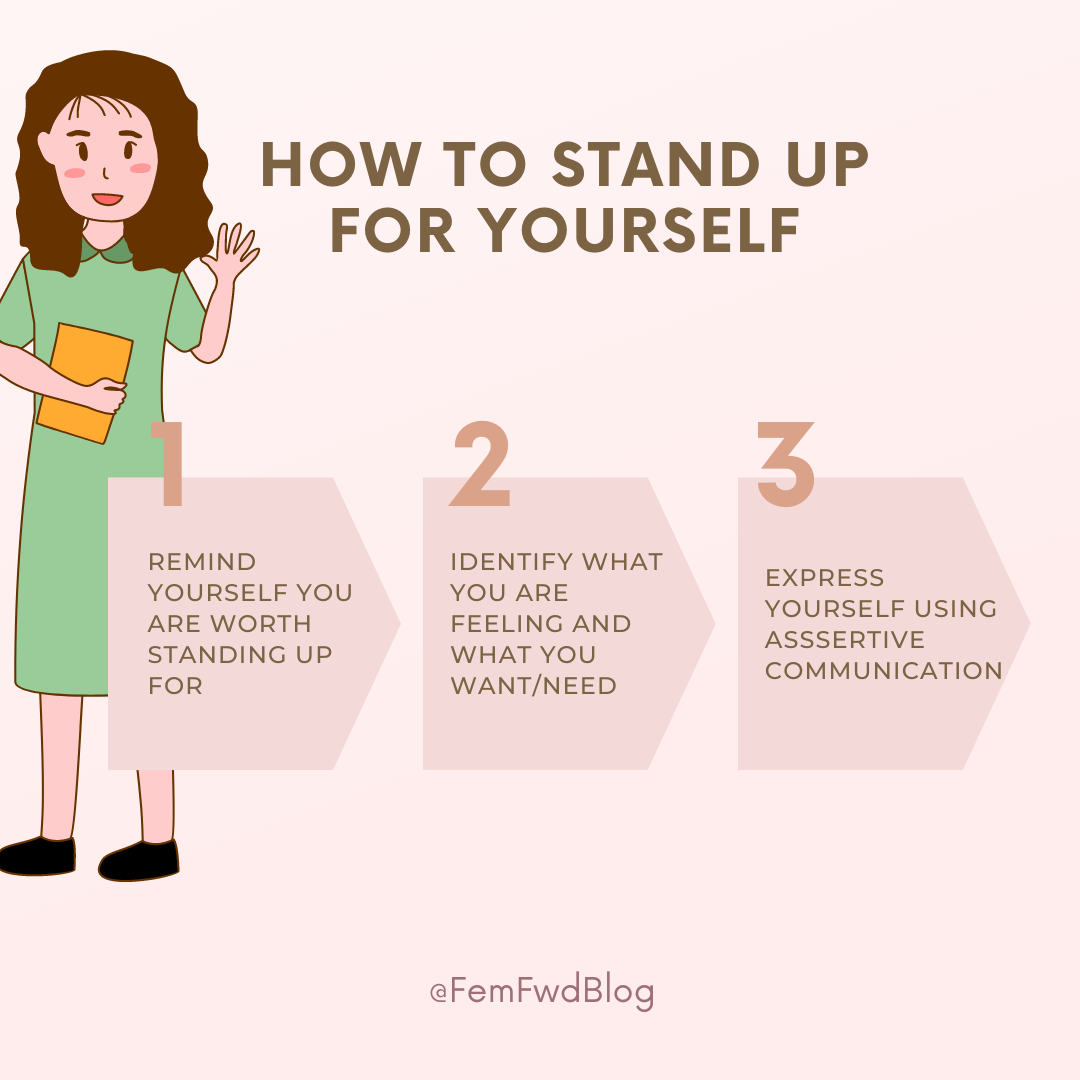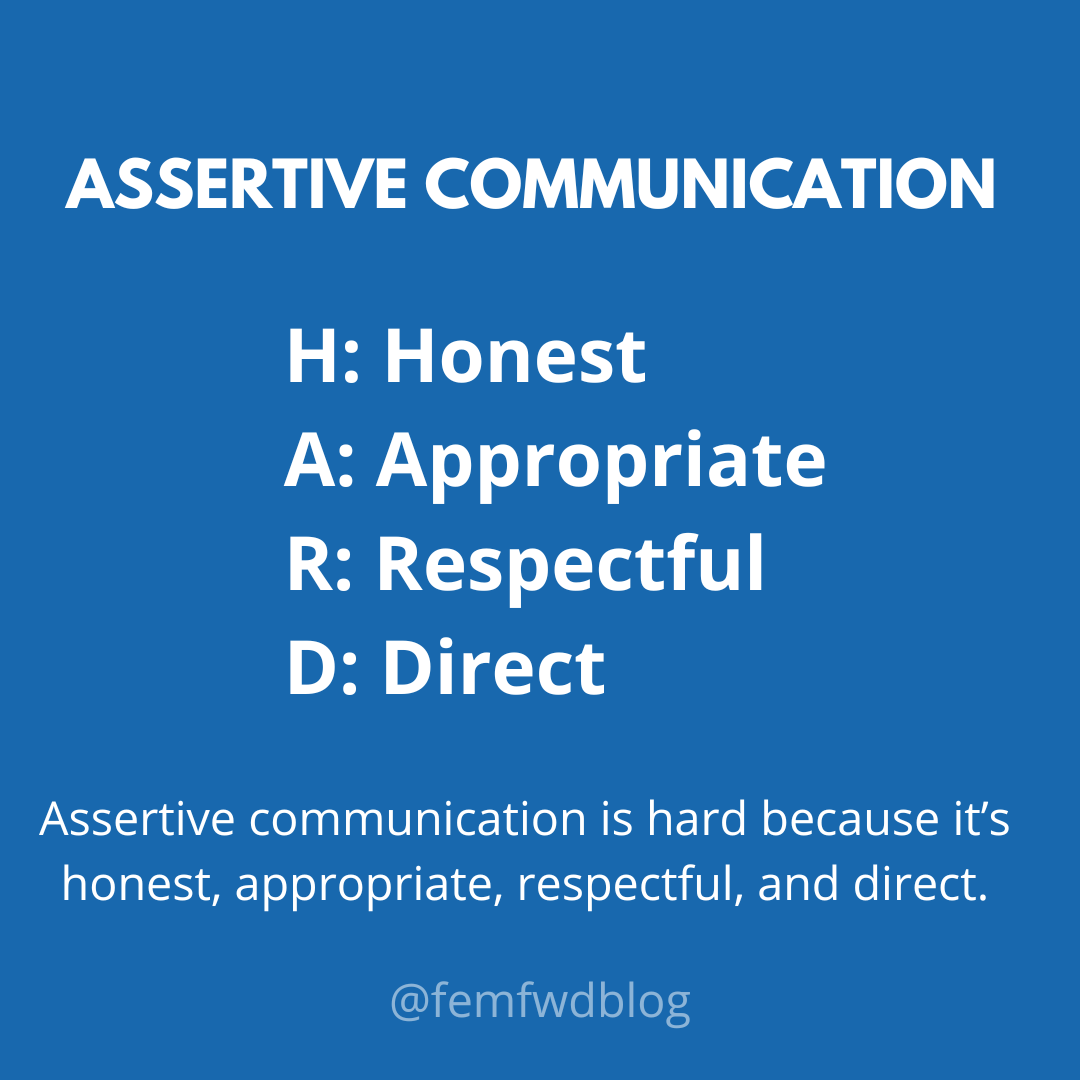How To Stand Up For Yourself
Unfortunately, if you are human, then you’ve been in the position of needing to stand up for yourself. This happens in all of our relationships and of course varies in the intensity and need depending on the relationship. For example, speaking up for ourselves can be as benign as needing to ask for the food or drink we never received at a restaurant or retuning a poor quality item to a store. It can also be a little more intense, such as letting a friend or partner know that their tone or choice of words was hurtful and we aren’t willing to engage with them in that way. Despite how frequently we need to stand up for ourselves, we really aren’t explicitly taught how to do it.
What is passive communication?
If you are here, it likely means you have trouble standing up for yourself, which may mean you have a passive communication style. In order to understand how to be more assertive, we need to be able to contrast assertive communication with passive communication. So let’s talk about the definition of passive.
Passive communication is dishonest in the sense that the speaker is not really saying what they actually mean. This can come in the form of downplaying the feelings they are having or sharing only a very a limited portion of what they are actually thinking/experiencing. It may also mean that they don’t even share at all and keep their feelings to themselves.
Similarly, passive communication is often indirect. It is indirect because passive communicators aren’t usually telling people exactly what they want or need. So if you’ve ever been on the revising end of passive communication you might leave an interaction thinking, “what exactly do they want me to do?” For example, a passive communicator might say something like, “Chinese food would be good, but I really like all types of foods. I could eat anything, I guess.” The odd’s are they are really craving Chinese, but we can’t really be sure, can we?
How to speak up for yourself using assertive communication
Assertive communication is tactful, clear, and direct. It lets the listener know that you have boundaries and communicates what those boundaries are.
Dr. John Gottman, a renowned couples therapist and researcher, uses the acronym HARD to help us remember how to define assertive.
Honest- Speaking honestly about our thoughts and feelings is easier said then done. This means that we are clearly communicating what we are feeling, what we need, and the behaviors that are and aren’t working for us.
Appropriate- As much as it would be nice to just spit out whatever it is we are thinking and feeling whenever and wherever we want, that’s not always appropriate. For example, getting out of a chair at a restaurant and going into the kitchen to tell our waitress we need more ketchup is not appropriate. So in order to communicate assertively, we need to think about whether the time and place is appropriate for the discussion we are wanting to have. For example, if you want to address something with your partner, it’s better to wait until you are in a private, distraction-free environment to do so.
Respectful- It isn’t enough just to be honest. Even honesty can sound rude and harsh with a certain tone of voice and posture. When you are speaking up for yourself make sure you choose respectful language. So this means no name calling, cursing, or harsh tone.
Direct- One of the common mistakes people make when standing up for themselves is to either beat around the bush or go on and on and on about what it is they are trying to say. Trim the fat and get to the point.
Relationship Workshop
If this information resonates and you feel like you need to work on your communication in relationships, check our how to communicate better workshop.
What is nonverbal communication?
When it comes to speaking up for yourself, what we say matters just as much as how we say it. How we say it includes all the non-verbals, including tone, body language, posture, etc.
Assertive nonverbal communication:
Normal volume voice and tone
Good eye contact
Upright posture
Passive nonverbal communication:
Soft voice and tone
Poor eye contact
A body posture that makes you look smaller
Assertive vs. Passive
Standing up for yourself in your relationship
(Passive Response): I think it’d be nice if we could try and maybe eat together more often.
*Your passive nonverbal might include poor eye contact, a soft voice, and a small posture.
(Assertive response): I feel frustrated when you are late for dinner, as I really enjoy eating with you in the evenings. I’d appreciate it if you made a point to leave work on time at the end of the day so we can have dinner together.
*Your assertive nonverbal’s might include good eye contact, a normal volume and even voice, and an upright posture.
Standing up for yourself to a stranger/aquantiance
(Passive Response): You’ve received your meal at the restaurant and it’s not what you ordered. You don’t send back your meal and just eat what you were given.
(Assertive Response): Excuse me. I ordered the hamburger, but received fish. I’d appreciate it if you could bring me a hamburger. Thank you!
Assertive Communication Examples and receive our Assertive Communication Examples PDF
“I am not comfortable with that.”
“I am not willing to have that discussion with you at this time.”
“Excuse me? I ordered no onions on my burger and unfortunately the one I received has onions on it. I’d really appreciate it if you could remake this order. Thank you.”
“When you talk to me like that, I feel threatened and belittled. I am not willing to talk with you when you interact with me like this.”
“No, thank you.”
If you wanting to learn more about assertive communication, please sign up for our newsletter and receive our free assertive communication examples PDF.
Boundaries in Relationships
Standing up for yourself doesn’t just start in the moment when someone is pushing you around or testing your limits. Standing up for yourself can come in the form of preventative limits or boundaries.
What are boundaries in relationships?
Simply put, boundaries are setting limits. The sooner we do this in relationships, the less likely we have long-term problems with people trying walk all over us. It sets the precedent.
This can come in the form of saying “No” to invitations all together or perhaps declining to participate in an activity that doesn’t interest you or match your values. Additionally, it is setting boundaries around our personal space and around our time. That might be as simple as letting people know you’re not available by phone after 8PM or declining a hug, if you’re not comfortable with that.
Of course, boundaries can be used in the moment to stand up for yourself, but theya re also preventative. They let people know what you and will not stand for, as well as inherently suggest that you are worthy and have value. This makes it less likely you’ll be in the position of needing to stand up for yourself.
To learn more about boundaries check out our boundaries article.
Consequences of Standing Up For Yourself
Increased self-esteem
Leaves you feeling more empowered
Increases your self-respect and self-worth
Increases satisfaction in relationships
Increases your ability to handle conflict
Relationship Advice For Women
As always, thanks for reading! We are all about teaching people, especially women, who to have more satisfying relationships. Sign up for our newsletter to receive our newest blogs right to your inbox!





